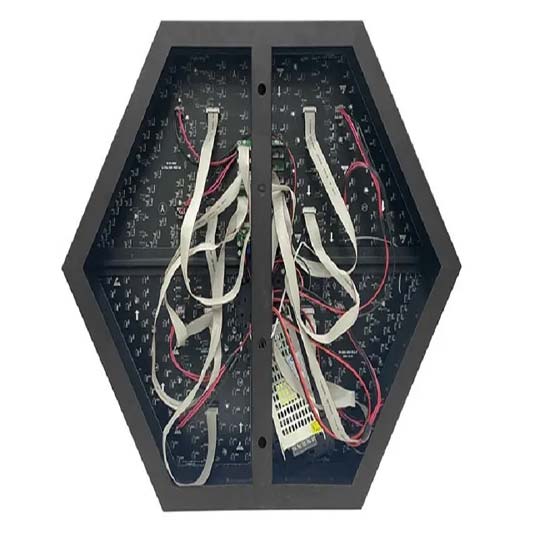
The LED industry has received more and more attention in recent years,because of its status in various public activities, it is difficult to ignore the exhibitionDo you know the seven types of LED screens?
LED displays are classified in various ways, generally in the following ways: (1) Divided into indoor, outdoor and semi outdoor according to the use environment The indoor screen area is generally less than 1 square meter to more than 10 square meters. The indoor LED display screen is used in the indoor environment. This type of display screen has moderate brightness, large viewing angle, short color mixing distance, light weight and high density, and is suitable for close viewing.The outdoor screen area generally ranges from several square meters to tens or even hundreds of square meters. The dot density is relatively thin (mostly 2500-10000 dots per square meter). The luminous brightness is 5500-8500cd / square meter (different directions, different brightness requirements). It can be used under direct sunlight. The viewing distance is more than tens of meters. The screen has good wind, rain and lightning protection capabilities.The semi outdoor screen is between outdoor and indoor, with high luminous brightness. It can be used outdoors without direct sunlight. The screen body is sealed to a certain extent, generally under the eaves or in the window.
(2) According to the color, it is divided into monochrome, double primary color and triple primary color (full color) Monochrome refers to the light-emitting materials with only one color on the display screen, most of which are single red, and yellow green can also be used in some special occasions (such as funeral parlors).The dual primary color LED display is composed of red and green LED lights. The dual primary color display of 256 gray levels can display 65536 colors (the dual color display can display red, green and yellow colors).The full-color LED display consists of red, green and blue LED lights, which can display white balance and 16777216 colors.
(3) Divided into synchronous and asynchronous according to control or use mode.
Synchronous mode means that the working mode of LED display screen is basically the same as that of computer monitor. It maps the computer image point by point at the update rate of at least 30 fields / second. It usually has the color display ability of multi-scale and can achieve the effect of multimedia advertising.Asynchronous mode refers to that the LED screen has the ability of storage and automatic play. The edited text and non grayscale pictures on the PC are transmitted to the LED screen through serial port or other network interfaces, and then the LED screen automatically plays offline. Generally, the LED screen has no multi grayscale display capability, and is mainly used to display text information, and can be networked on multiple screens.
(4) Divided by pixel density or pixel diameter As the LED dot matrix module used in the indoor screen has relatively uniform specifications, it is generally divided according to the pixel diameter of the module, mainly including: ∮ 3.0mm 62500 pixels / m2 ∮ 3.75mm 44321 pixels / m2 ∮ 5.0mm 17222 pixels / m2 Indoor surface mount pixel points:
P1.58 400689 points / m2 P1.9 277000 points / m2 P2.0 250000 points / m2 P2.5 160000 points / m2 P3 111111 points / m2 P4 62500 points / m2 P5 40000 points / m2 P6 27777 points / m2 P7.62 17222 points / m2 P8 15625 points / m2 P10 10000 points / m2
Pixel diameter and pixel number of outdoor screen
P10 10000 points / m2 P12.5 6400 points / m2 P16 3906 points / m2 P20 2500 points / m2 P25 1600 points / m2 P31.25 1024 points / m2
(5) According to the display performance, it can be divided into:
Video display: generally full color display Text display: generally single primary color display Graphic display: generally double primary color display Market display: generally digital tube or single primary color display;
(6) According to the display device, it can be divided into:
LED digital display screen: the display device is a 7-segment code digital tube, which is suitable for making an electronic display screen such as a clock screen, an interest rate screen, and displaying numbers. LED dot matrix graphic display screen: the display device is a dot matrix display module composed of many evenly arranged light emitting diodes, which is suitable for playing text and image information. LED video display screen: the display device is composed of many light emitting diodes, which can display various video files such as video and animation.
Conventional LED display: steel structure is used to fix the display in one position. The main common ones are outdoor large-scale single column LED advertising screens, and single and double color LED display screens installed on the walls in the station to broadcast train number information.
Rental LED display screen: in the design, the R & D Department considered that the screen is often used for installation and disassembly, so the left and right boxes are connected with quick lock with positioning function, and the positioning is accurate. The installation of the whole box is completed within 10 seconds. Rental screens are mainly used for stage performances, wedding venues and large spring festival galas.
(7) According to the development direction, it can be divided into:
The "advertising media display screen" that has been widely used: the banner single and double color display screen at the door head, the full-color display screen on the surface of the square building, mainly for advertising; The "industrial indicator display screen" is quietly rising: it is provided with auxiliary display screens for PLC DCS and other distributed control systems, such as speed, flow, temperature, pressure, etc.
